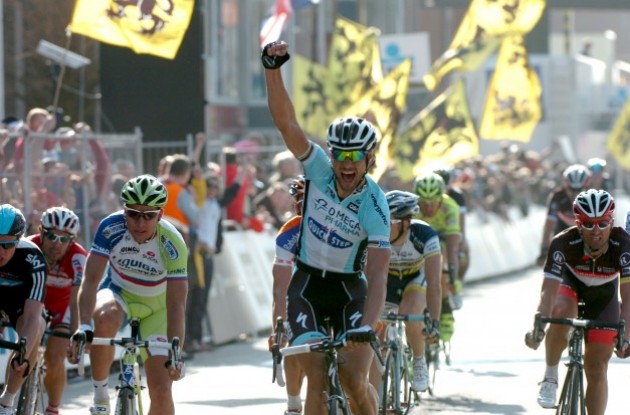The Lion of Flanders and Being Aero
It’s classics season again and you know what that means. No, not curb to curb crashes, or drunken shenanigans from the locals. I mean the iconic flag that is virtually the symbol of these springtime classics – the Lion of Flanders.
As fans of cycling we’re all familiar with this iconic image, a black lion with red claws and tongue on a yellow background. However, as with all flags there is symbolism behind the Lion of Flanders.
There are two different types of Lion of Flanders flags and as a fan of cycling you want to make sure you buy the correct version. The lion with the red claws and tongue is the flag that is most commonly seen flying at races. However, don’t mix this up with the all black lion. This all black Lion of Flanders is a symbol of a separatist movement of Flanders that wants to remove itself from the Belgian government.
From here the symbolism of the all black lion gets murkier depending on whom you talk to. The all black lion is associated with a right-wing political group. If you wave it around indiscriminately you could be headed for a rather heated political discussion that you want no part of. Today, the red claw and tongue lion is the official Lion of Flanders, but occasionally the all black lion is also used in conjunction with the “official” Lion of Flanders.
Understanding the Lion of Flanders requires a brief lesson on Belgium. The country is basically split into two distinct areas: the northern Flemish part, in which the population speaks Dutch, and in the south we have the Wallons, who speak French.
Tensions between these two groups occasionally flared up and until 1967 the Belgian constitution had still not been translated from French into Dutch, giving the impression to the Flemish that the Dutch speaking natives were second class citizens.
To muddy the explanation even more there is another term used almost interchangeably – Flandrien, which is a derogatory term for the people from the north of France. There was a lot of poverty in these areas at the beginning of the 20th century and the people from Flanders went to work in northern France. The French thought they were taking jobs away from their own people and sarcastically called them “les Flanderiens.” These Flanderiens were stereotypically considered hard workers. This term was picked up and romanticized to describe the Flemish cyclists.
Many years ago when I traveled to Roubaix, I cheered “Go Belgium” to a bunch of local fans who were waving Lion of Flanders flags. I was told rather brusquely that they were not Belgian but Flemish. Whoops, my bad, and I quickly slunk away before they decided to hang me from the nearest lamppost.
So when you are in Belgium and you spot the roadside vendor on the Muur, thanks to RoadCycling.com you now know which version of the Lion of Flanders flag to spend your Euros on. Oh, and pick one up for me as well.
While we’re on the subject of “educational” posts I posed a question to social media last week after watching the breakaway in E3 Harelbeke. Four riders escaped from the peloton. Riding together they managed to stay away with Peter Sagan (Cannondale Pro Cycling) taking the win. Because I’m kinda dorky and always looking to shave a few seconds off my Strava segment to the local Starbucks, I couldn’t help but notice the different riding styles of the quartet and wondered about any benefits and drawbacks each of them had.
In an effort to stay away and be as aero as possible, they were employing various positions on the bike: one guy was in the drops, another riding with his hands on the brake hoods and Sagan was stretched out resting his forearms on the tops of the bars.
Speaking to a few experts in bicycle aerodynamics, as well as poking around some cycling forums, resting your forearms on the tops is the fastest position to slice through the wind. Imagine a wing on an airplane – the front of the wing has a leading edge, slightly bulges and then trails off. This shape is for the wind to have contact with the wing and improves the aerodynamics. Look at an airplane – there are no straight, flat lines. Everything is curved.
However, what I thought was interesting was that keeping the head in a more upright position is better for aerodynamics. You look at America’s five time professional time trial champion David Zabriskie and his back is flat when in time trial position on his bike. Turns out that isn’t a good aerodynamic position. Note that I didn’t say it’s a “bad position” in itself – just not an aero one. Obviously DZ could get up to speed to win the race against the clock. A slightly humped back is more aerodynamic, but that doesn’t mean Zabriskie could curve his back. I know the former Team Garmin-Sharp-POC rider has spent plenty of time in the wind tunnel working on his position and if anything would have made him faster he would have adapted accordingly.
In contrast I was shown a photo of Chris Boardman when he broke the Merckx-style hour record riding with his hands in the drops. Boardman’s elbows are bent at almost 90 degrees. For those who may not realize, the UCI banned numerous aerodynamic positions and limited the allowed position to how we ride a standard road bike.
The Englishman’s position for the hour record was perfect. However, if you take a closer look you can see that the bars are actually a bit longer, allowing him to rest his wrists and a bit of his forearms on the bar. Boardman was definitely working the rules to the limit and who could blame him. Some riders have the physiological capacity to beat the record, but not the mental ability to suffer in the red zone, unable to move or adjust their position.
As we saw Sagan outsprinted his breakaway companions including riders that were wearing aerodynamic helmets. So while being aero is critical nothing can beat just being the strongest.
Gear up for your own aerodynamic spring rides in our bike shop and follow Roadcycling.com on Twitter, Facebook and Google+. If you're located in the USA, please also check out our video highlights from this year's Volta Ciclista a Catalynya in our videos section.
Recently read articles
At last years worlds you may remember it was teaming with rain, well I was forced to stand under it between jaunts in and out of a Florentine bar about 400 meters from the finish. The upside was that it was lousy with rabid Belgians or should I say drunken Flemish cycling fans? I was rocking an Irish Cycling tee because Canada had failed to select anyone who could possibly win. Once Dan Martin and Roche were finished they declared "Ireland is finished, you are for Belgium now", they had face paint in hand to emphasize the point. What could I do? Explain my parents were Irish Italian? Thought it was better to submit to a brown yellowish hue streaked across my forehead. NOW THAT IS EUROPEAN CYCLING!!! Go at least once and see its passion.








